World Mental Health Day: How to support your friends
October 10, 2020
Trigger Warning: This article discusses in-depth information about serious mental illnesses.
In light of World Mental Health Day, it is important to break the stigma surrounding mental illness and learn how to fully help friends and family struggling. Mental illness isn’t an easy topic to discuss but normalizing open conversation is an essential step in creating an environment where people feel comfortable to reach and ask for help.
It can be hard to understand what someone is truly going through but that doesn’t mean you can’t take the steps to make those who are suffering feel as supported as possible. We outlined certain mental illnesses and their common misconceptions, what you may be doing wrong and the best ways you can help.
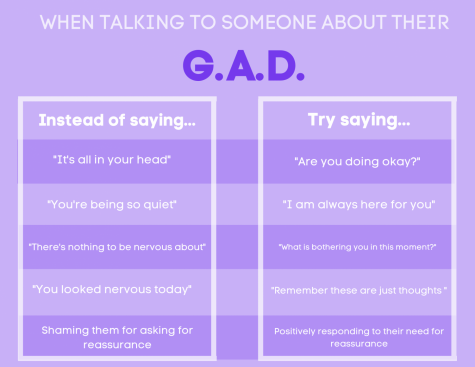
Generalized anxiety Disorder
Generalized anxiety disorder, also known as GAD, is defined as “Severe, persistent anxiety that is hard to control and interferes with daily activities.” Psychological symptoms of this disorder include intense overthinking, difficulty handling uncertainty, feeling restless, inability to concentrate, always being prepared for the worst outcome and indecisiveness. However, those with GAD can also experience heavy physical symptoms such as fatigue, trouble sleeping, muscle ache, trembling, irritability, nausea/stomach pain and nervousness.
GAD is a very serious condition that can be hard to control; although it can lead to anxiety attacks, the worry is always there and interferes with activities in your daily life. Unlike a panic disorder, anxiety attacks from GAD usually have a direct cause or trigger even if it’s unknown to the sufferer at the time.
Although the disorder is debilitating on its own, misconceptions and stereotypes can be half the battle for someone with GAD. If you are trying to help and comfort someone with it, consider these tips.
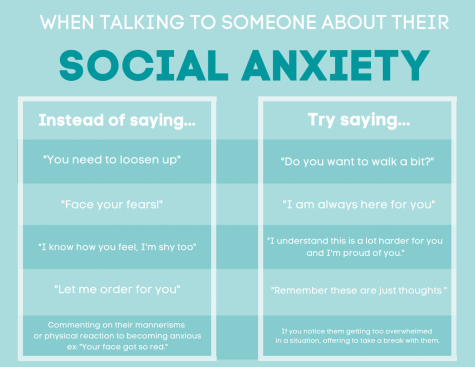
Social phobia
Social phobia, also known as social anxiety, is another type of anxiety order defined as “A chronic mental health condition in which social interactions cause irrational anxiety.” Psychological symptoms include the constant worry of humiliating yourself, avoiding attention at all costs, the fear people will judge you for being anxious, the fear of talking to strangers, overanalyzing past social situations and overthinking things you did wrong. Similar to GAD, this condition has physical symptoms as well, which include blushing, a fast heartbeat, trembling, sweating, stomach pain, dizziness and muscle tension.
Like GAD, social anxiety lingers through someone’s daily life and it’s there whether they want it to be or not. Even if they, to some extent, know their feelings about social interactions are irrational, it doesn’t make them any less real.
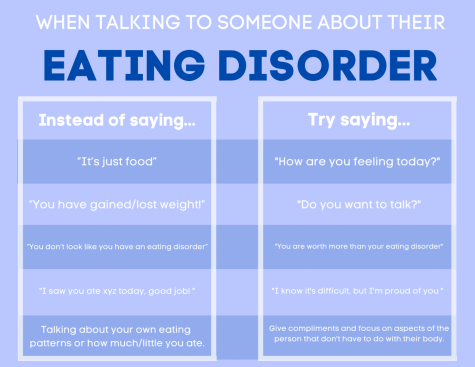
Eating Disorders
Eating disorders are defined as “serious conditions related to persistent eating behaviors that negatively impact your health, your emotions and your ability to function in important areas of life.” The most common types of eating disorders are Anorexia Nervosa, Bulimia Nervosa and Binge-eating disorder.
These disorders present themselves in all different ways, but there are some key symptoms you can look out for. These include, but are not limited to, rapid weight loss/gain, frequent talking about their body or new diet, refusing to eat around friends, eating very small or very large portions of food, certain eating rituals and increased obsession with weight or calorie intake. Physical signs could include stomach cramps, difficulty concentrating, dizziness, hair thinning, dry and brittle skin, extreme exhaustion and many others.
Someone with an eating disorder does not look or act a certain way; they can affect anyone at any time and the symptoms and behaviors look different for everyone. Getting it under control can be very difficult, leaving sufferers of these disorders especially vulnerable to the world around them. Sometimes you can have the best intentions with saying certain things, but it can be the very reason someone potentially falls into a relapse. That is why it’s important that even if you can’t fully understand what the person is going through, you can say the right things that help them out the most.
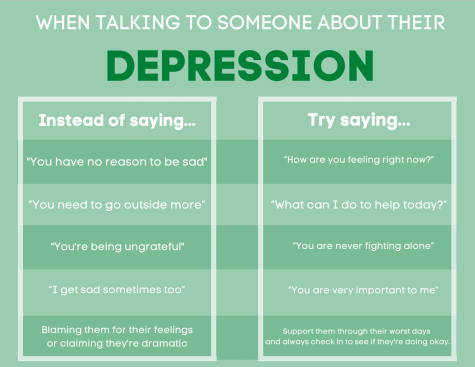
Major depressive disorder
Major depressive disorder, more commonly known as depression, is defined as “a disorder characterized by persistently depressed mood or loss of interest in activities, causing significant impairment in daily life.” Psychological symptoms of this depression include feeling sad or in a depressed mood, loss of interest or pleasure in activities once enjoyed, feeling worthless or guilty, difficulty thinking, concentrating or making decisions and thoughts of death or suicide. Physical symptoms may include changes in appetite such as weight loss or gain unrelated to dieting, trouble sleeping or sleeping too much, loss of energy or increased fatigue, increase in purposeless physical activity (pacing, handwringing, restlessness) and slowed body movements/speech.
Depression is an extremely difficult disorder to manage whether you’re a child, teen or adult. Although it can range in severity, thoughts of death and suicide are common and dangerous. It can be hard to fully understand what the person is truly going through and asking/being asked to get help can be scary tough for everyone involved. In order to reach the step of getting help, someone with depression must feel comfortable enough in their situation to reach out to a friend or loved one; there are some steps you can follow and things you can say to make a comfortable environment possible.
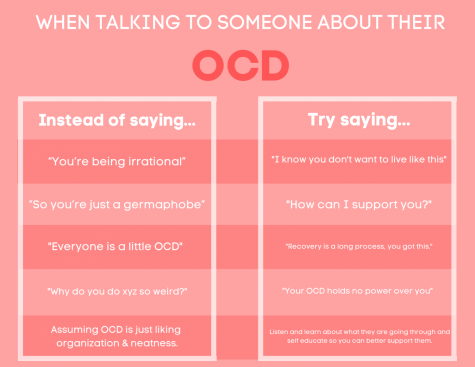
Obsessive compulsive disorder
More commonly known as OCD, obsessive compulsive disorder is defined as “A disorder characterized by excessive and unreasonable thoughts/fears that lead to compulsive behaviors.” OCD is split into two types of symptoms: obsessions and compulsions. Obsessive symptoms include fear of contamination or dirt, difficulty handling uncertainty, needing things orderly and symmetrical, aggressive thoughts about harming yourself or others and unwanted, horrific thoughts/feelings. These obsessions can lead to compulsions such as washing/cleaning hands until they’re raw, repeatedly double checking, counting in certain patterns, orderliness, following a strict routine and demanding reassurance.
OCD is an extremely misunderstood disorder that is often grossly oversimplified by people who just think it’s wanting things clean and organized; it is much, much more than that. Here are some things to consider when approaching/talking about this disorder.
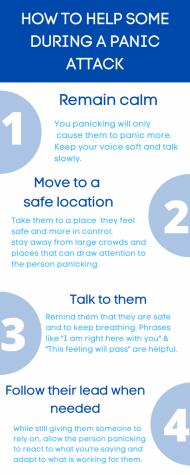
Panic disorder
A panic attack is defined as “a sudden episode of intense fear that triggers severe physical reactions when there is no real danger or apparent cause.” When an attack occurs, the person may feel a surge of overwhelming panic, feel like they’re losing control or feeling detached or unreal. Certain physical signs include hyperventilation, Heart palpitations or chest pain, vomiting/stomach cramps, trembling, hot flashes and more.
Unlike an anxiety attack, a panic attack for someone with panic disorder usually has no apparent cause and starts completely at random; it is something the person cannot avoid. Because these attacks are so random, if someone you know suffers from panic attacks you’ll want to be prepared for when it strikes and effectively help them calm down. On average, attacks can last from 5-20 minutes.
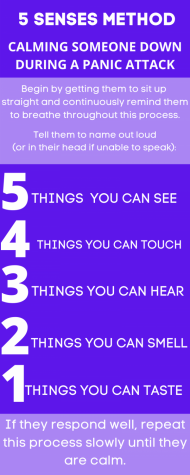
There are also specific methods designed to help calm people while experiencing a panic or anxiety attack such as the ‘5 Senses Method.”
What you can do
On days like World Mental Health day, we need to take time and reflect on the struggles those with mental illness go through everyday. With a shameful stigma and lack of understanding from others, they are constantly fighting a silent battle with themselves which is isolating and exhausting. When we educate ourselves on the best ways to break the stigma of mental illness we are creating an environment that is safe for someone to ask for help.
If you or someone you know is struggling, know that it is always okay to reach out, no matter how scary. It’s a big step, but the first step in overcoming and recovering. If your environment isn’t a safe space to reach out to, there are many alternatives to get the help you’re looking for:
- Look at a list of telephone hotlines and text lines you can contact in a crisis or if you’re just looking for someone to talk to.
- Reach out to a school counselor or trusted friend that you know would provide you with adequate information and resources (yes your counselors are here to help you!)
- Contact public health services, college and university organizations or even your primary care physician; often these public organizations will provide low to no-cost therapy or connect you to someone that will.
- Support groups are a great way to connect with others just like you and provide a safe space to talk about what you may be going through; there are even online ones you can attend if you don’t feel comfortable going in-person.
- Educate yourself on certain treatment options that are financially available and beneficial to you. There are so many ways you can help yourself and others, it’s just about finding what works for you.
There are also many ways you can work to break the stigma around mental illness and be a better ally to those suffering. Consider these tips:
- Educate yourself on mental illness and what someone goes through on a daily basis. Oftentimes the stereotypes stem from lack of knowledge and overall ignorance to mental health issues. Knowing the signs of mental illness can be essential to protecting yourself and your friends, family and loved ones.
- Check up on your loved ones whenever you can. Mental health isn’t always visible and you never know what someone is going through. Even if they seem fine, always reach out and tell them you’re there to talk.
- Be conscious of the language you use when talking about mental health. There may be phrases or words that are doing more harm than good. Make sure you are listening when someone tells you what you’re saying is problematic or triggering
- Create an open conversation of mental health in extracurriculars you’re involved in. Mental illness is treated as a taboo topic when in reality, so many struggle with it everyday; normalize speaking and checking up on others.
Whatever you are going through and however you are coping, you are not alone. Mental illness is never something to be ashamed of and you deserve to feel better, always. Today and everyday, reflect on your journey with mental health and the work you have done; we see you, we hear you and we are so proud of you.


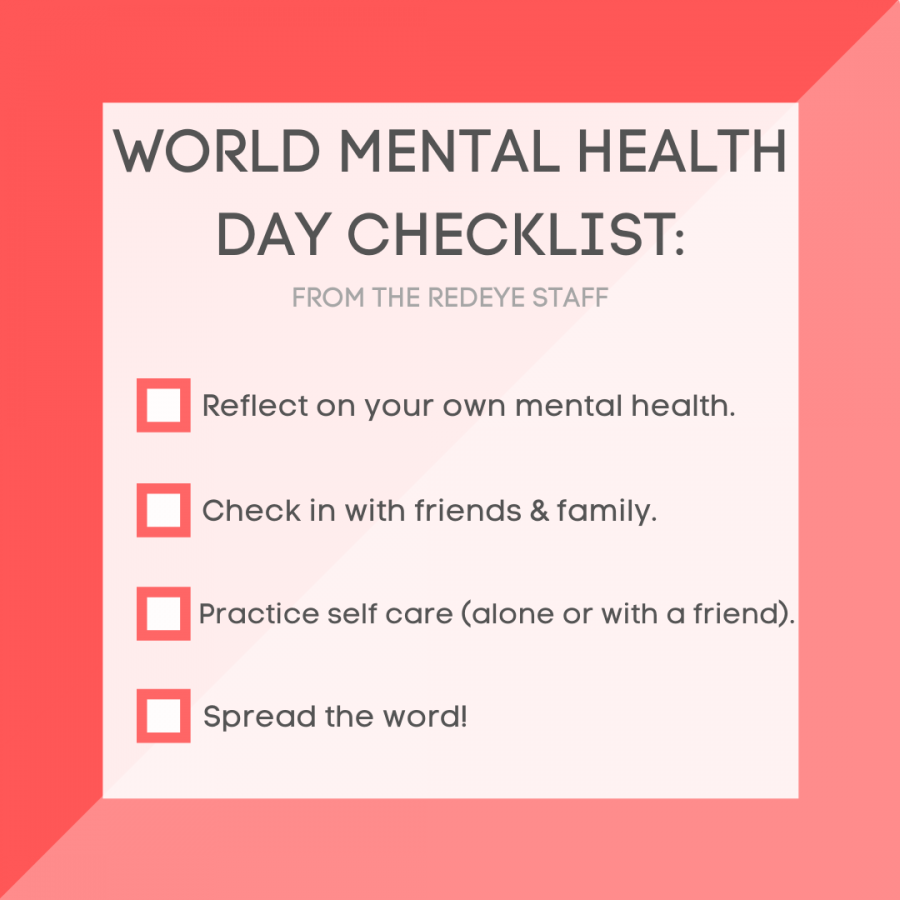









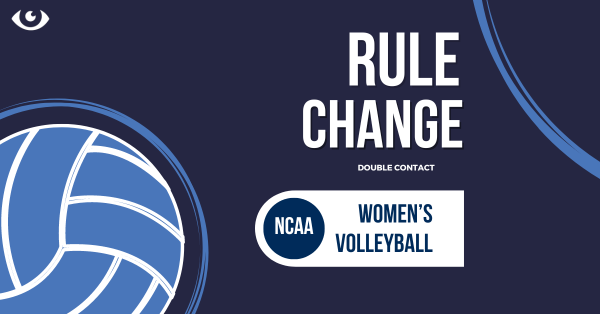
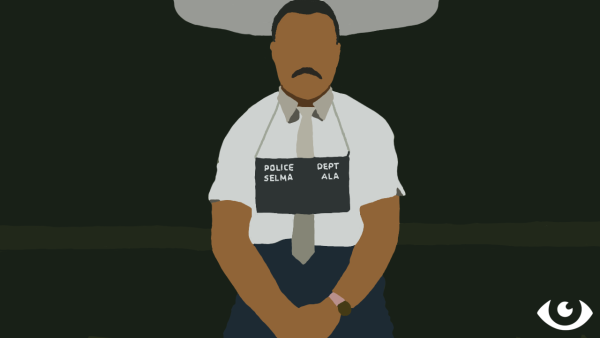

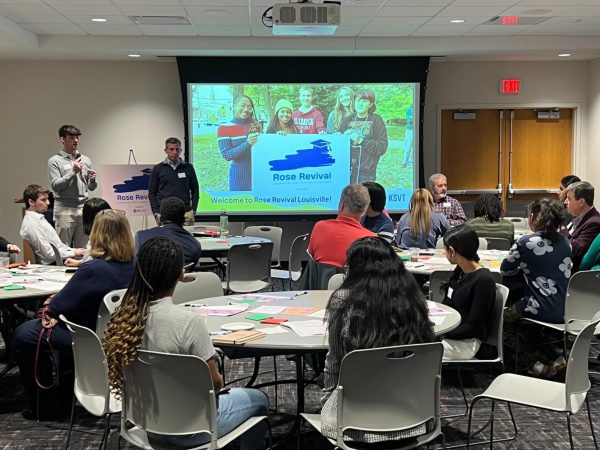



Maryle Carns • Oct 11, 2020 at 9:37 am
Amazing ,informative article by these two writers. Such a wealth of information that explains all types of anxiety that affects many many people. It is such a positive explanation encouraging conversations and openness regarding mental health.